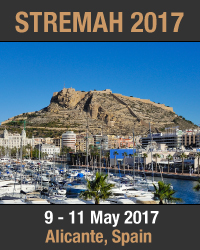15th International Conference on Studies, Repairs and Maintenance of Heritage Architecture
9 - 11 May, 2017
Alicante, Spain
Introduction
STREMAH 2017 is the 15th International Conference on Studies, Repairs and Maintenance of Heritage Architecture. The meeting has taken place on a regular basis since the first conference started in Florence (1989) and continued in Seville (1991); Bath (1993); Crete (1995); San Sebastian (1997); Dresden (1999); Bologna (2001); Halkidiki (2003); Malta (2005); Prague (2007); Tallinn (2009); Tuscany (2011), the New Forest, UK home of the Wessex Institute (2013) and A Coruna, Spain (2015).
The importance of retaining the built cultural heritage cannot be overstated. Rapid development and the inappropriate conservation techniques are threatening many built cultural heritage unique sites in different parts of the world. This conference aims to provide the knowledge required to formulate regulatory policies, to ensure effective ways of preserving the architectural heritage. The series has been most successful and the conference continues to attract a wide range of high quality contributions since it started in 1989.
The meeting addresses a series of topics related to the historical aspects and the reuse of heritage buildings, as well as technical issues on the structural integrity of different types of buildings, such as those constructed with materials as varied as iron and steel, concrete, masonry, wood or earth. Restoration processes require the appropriate characterisation of those materials, the modes of construction and the structural behaviour of the building. This knowledge can be gained through a series of material characterisation techniques, preferably via non-destructive tests. Modern computer simulation can provide accurate results demonstrating the stress state of the building and possible failure mechanisms affecting its stability. Of particular importance are studies related to their dynamic and earthquake behaviour aiming to provide an assessment of the seismic vulnerability of heritage buildings.
This conference brings together contributions from scientists, architects, engineers and restoration experts from all over the world dealing with different aspects of heritage buildings. Papers contained in the volumes in the series have been published in paper and digital format in the WIT transactions of the Built Environment, and widely distributed around the world. They are also permanently archived in the Wessex Institute eLibrary where they are available to the international community http://www.witpress.com/elibrary.
The importance of retaining the built cultural heritage cannot be overstated. Rapid development and the inappropriate conservation techniques are threatening many built cultural heritage unique sites in different parts of the world. This conference aims to provide the knowledge required to formulate regulatory policies, to ensure effective ways of preserving the architectural heritage. The series has been most successful and the conference continues to attract a wide range of high quality contributions since it started in 1989.
The meeting addresses a series of topics related to the historical aspects and the reuse of heritage buildings, as well as technical issues on the structural integrity of different types of buildings, such as those constructed with materials as varied as iron and steel, concrete, masonry, wood or earth. Restoration processes require the appropriate characterisation of those materials, the modes of construction and the structural behaviour of the building. This knowledge can be gained through a series of material characterisation techniques, preferably via non-destructive tests. Modern computer simulation can provide accurate results demonstrating the stress state of the building and possible failure mechanisms affecting its stability. Of particular importance are studies related to their dynamic and earthquake behaviour aiming to provide an assessment of the seismic vulnerability of heritage buildings.
This conference brings together contributions from scientists, architects, engineers and restoration experts from all over the world dealing with different aspects of heritage buildings. Papers contained in the volumes in the series have been published in paper and digital format in the WIT transactions of the Built Environment, and widely distributed around the world. They are also permanently archived in the Wessex Institute eLibrary where they are available to the international community http://www.witpress.com/elibrary.
Conference Topics
The following list covers some of the topics to be presented at STREMAH 2017. Papers on other subjects related to the objectives of the conference are also welcome.
- Heritage architecture and historical aspects
- Learning from the past
- Surveying and monitoring
- Maintenance issues
- Rehabilitation of metallic structures
- Earth construction
- Modern (19th/20th century) heritage
- Ports and coastal heritage
- Heritage masonry structures
- Wooden structures
- Simulation and modelling
- Material characterization
- New technologies and materials
- Corrosion and material decay
- Seismic vulnerability and retrofit
- Management and assessment of heritage buildings
- Re-use of heritage buildings
- Heritage and tourism
- Conservation policies
- Guidelines, codes and regulations for heritage
- Heritage management
- Defence heritage
- Industrial heritage
- Transportation heritage
- Social, cultural and economic aspects
- Adaptability and accessibility
- Monitoring and damage detection
- Vernacular architecture
- Safety and security
Find out more on the conference webpage.
